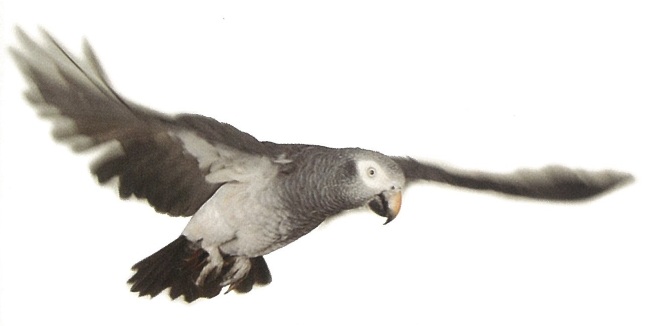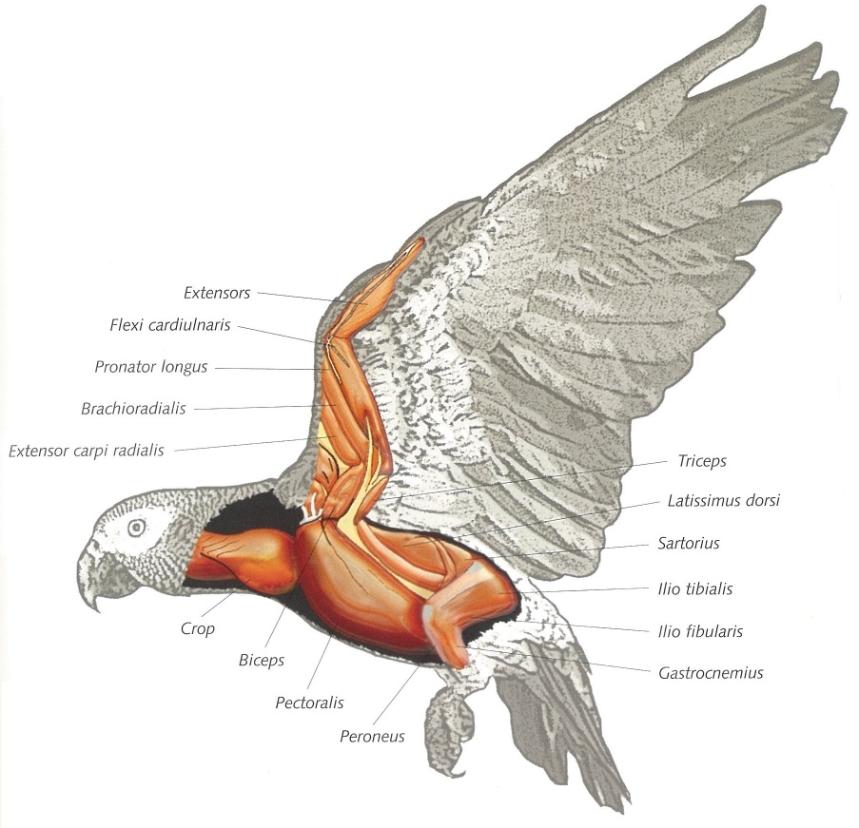Greys normally leave the nest (fledge) at about 13 weeks of age but they remain highly dependent on their parents for their food and safety for many more months. On first leaving the nest, the fledglings make their first attempts to fly. While the urge to fly is very strong in greys at this age, their abilities to fly are very poor. This is because the skills of flying have to be learned by each bird through simple trial and error experiences. Young birds will practise flapping while perched. This helps to strengthen their pectoral muscles (the main muscles used to fly) and gives them the 'feel' of the power of their wings and the lift this generates. Soon they gain the confidence to take off for their first flight but usually they crashland clumsily. However, after a few days their abilities to manoeuvre and control their speed and direction while airborne begin to improve and they soon land with more precision.
Trial and error develops the skills In the wild birds try to face into wind when taking off (just as aircraft do), since the faster the air moves over the wings, the more 'free' lift the birds obtain. Captive birds rarely enjoy this advantage. It can take them longer to learn to fly well indoors where space tends to be very limited and there is no wind to help point them in the right direction when taking off and landing. However, after a few weeks, most captive-bred birds will have developed their flying techniques very well and become adept at using these skills.
Young birds gotta fly!
In captive-bred greys it is vital to encourage these youngsters to fly at this stage. This ensures that the birds develop normally and that their muscles, including their heart, also develop as they should. If such young birds are denied the opportunities to learn to fly, they often remain unable to fly properly for the rest of their lives. This in itself can cause the birds behavioural problems as they are unable to 'escape' from things which frighten them by flying away. Instead, they may become 'phobic' birds with an exaggerated fear of harmless objects or actions.Trial and error develops the skills In the wild birds try to face into wind when taking off (just as aircraft do), since the faster the air moves over the wings, the more 'free' lift the birds obtain. Captive birds rarely enjoy this advantage. It can take them longer to learn to fly well indoors where space tends to be very limited and there is no wind to help point them in the right direction when taking off and landing. However, after a few weeks, most captive-bred birds will have developed their flying techniques very well and become adept at using these skills.

Both young birds and adults sometimes prepare themselves for flight by flexing their wings often in a playful manner. When intending to fly to an unfamiliar place, the birds can take some time to make the final decision to take off.

The propeller-like twist in the primary feathers graphically
reveals the thrust at play as this Timneh is half-way through
his downstroke.
reveals the thrust at play as this Timneh is half-way through
his downstroke.

The small muscles within the wing are used to changes its shape and the angle at which it meets the air.
It is the massive pectoral muscles in the chest which give power to the wing during flapping flight.
This arrangement of the muscles makes the bird's body very compact and keeps the centre of the gravity low.
It is the massive pectoral muscles in the chest which give power to the wing during flapping flight.
This arrangement of the muscles makes the bird's body very compact and keeps the centre of the gravity low.